There’s a slow clip-clop of feathery steel-shod feet on pavement and the growl of a bullocky admonishing his charges. There are ladies in bonnet hats aboard sulkies pulled by ponies, and bow-legged men on frisky thoroughbreds. There are hay and wool bales. There’s the smell of horses and warm whiskered breath; the beat of big hearts. This is the main street of Surat, in South West Queensland, 100 years ago.
The calm is shattered as a cream-coloured coach rattles past, pulled by five grey horses. Fred “Tommy” Thompson is in the driver’s seat, and he’s in a hurry. The mail must reach Yuleba, a rural town about 76km north east of Surat. The date is 14 August 1924 and this is the last Cobb & Co coach to run in Australia.

A replica of that horse-drawn vehicle, appropriately called the Tommy Thompson, usually resides as a static display in Surat’s Cobb & Co Store Museum, but for 10 days in August 2024 it was given horses and came alive. The coach was the headline act of the Cobb & Co Festival, which every five years celebrates the contribution this iconic transport link made to inland Australia.
Starting a legend
American businessman Freeman Cobb and his partners established stagecoach routes in Victoria in 1853 to service the goldfields by connecting people to trains, delivering the mail and hauling gold. Their reach extended to New South Wales in 1862 and to Queensland in 1866. Although Cobb sold out less than a decade after establishing the mega-successful business, his name is forever associated with the company that ran coaches across Australia (and later established coach services in New Zealand, South Africa and Japan).
The Cobb & Co Festival is jointly held between Surat (population 402) and Yuleba (population 271), the two towns connected by the last mail run. I’m here in the centenary year of 2024, and people are arriving in their thousands to join the festivities. A small crowd gathers at the New Royal Hotel to reminisce and share stories. A poem called Coaching Days is read and in it is this line: “Jim Davidson, too, whose genial face, Beamed with joy as he went his pace; How happy he was with his team of greys; And the wild bush life in the coaching days.”
“My grandfather and great grandfather were both called Jim Davidson and they both drove Cobb & Co coaches along the Surat–Yuleba route,” Robyn Palethorpe says. “I think it’s Jim Senior mentioned in the poem because he was well known for his team of greys. The three lead horses were named after his daughters – Pearl, Aileen and Florence.”
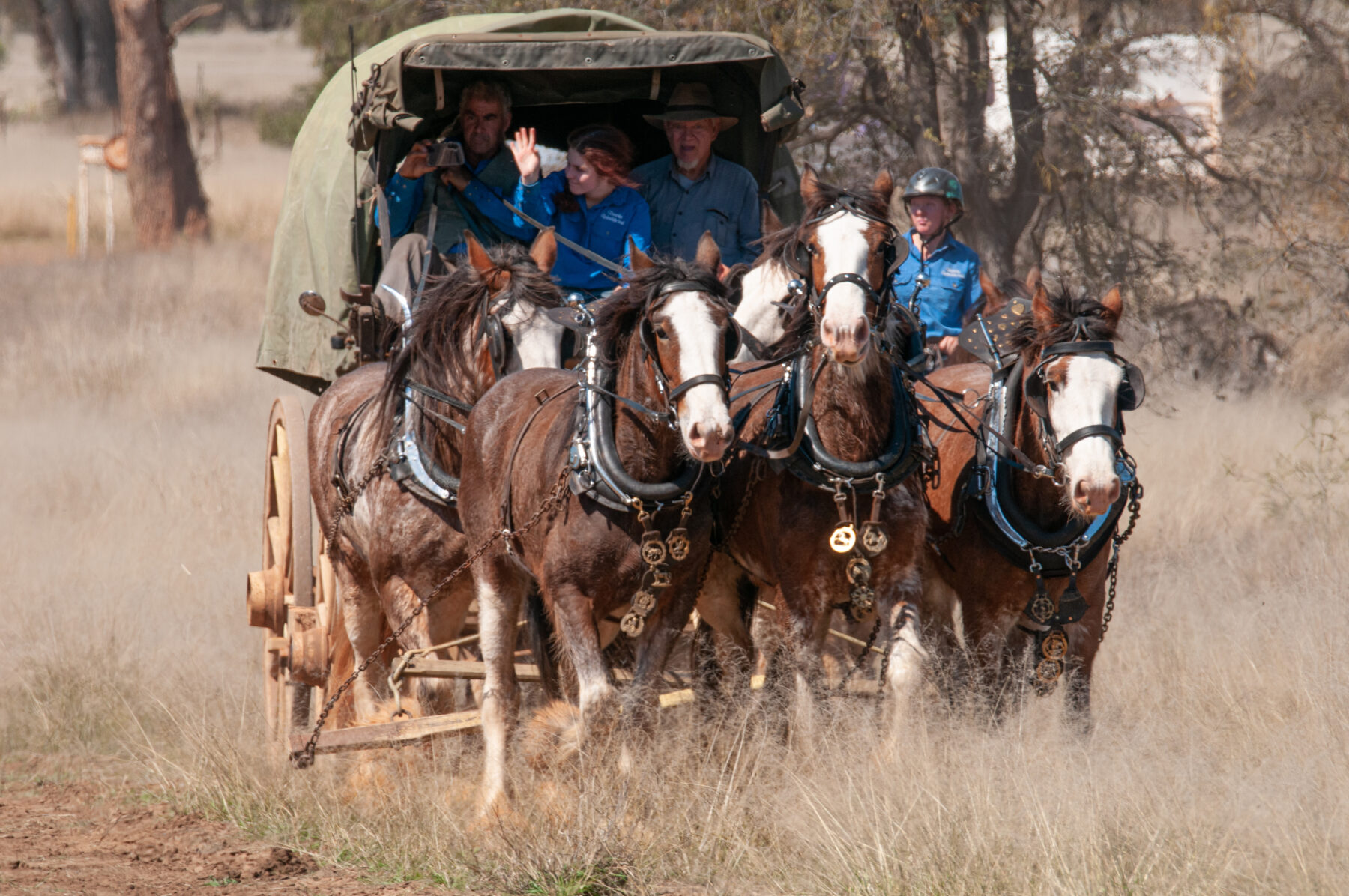
Also in attendance are Nea MacCulloch and Bev Giveen, friends from Sydney who’ve been travelling with period outfits. Both will take their place on the coach in coming days. They proudly display old photos of their ancestor John Ireland, a coach driver in 1828, long before Cobb & Co was founded. They share stories of travellers being thrown from the coach as it overturned on rough roads, when passengers were expected to help right it. The journey had to continue because mail needed to get delivered, so a sapling was tied to the undercarriage as a running repair.
Grand reenactment
On the edge of Surat, away from fractious horses, Rod Sansom, of Oakfield Ranch near Newcastle, is offering rides in his maroon and gold coach, the colours favoured by Cobb & Co in NSW. His coach is pulled by camels. “Cobb & Co would use camels in the outback desert country in places like Alice Springs and Broken Hill,” Rob explains. “In [desert] country, the camels trot along as fast as horses. They used this combination – three [camels] in the lead and two in the poll – because it was more manoeuvrable than longer teams.” Today, a camel named “Thirsty” is one of the three camels in the lead. “Thirsty is a good lead camel; you can talk to him and give him directions,” Rob says. Thirsty is also a racing camel and has been known to drink beer.
On a street by the river, the teamsters, having walked from Yuleba earlier in the week, are plying their trade. Phil Thomson’s bullocks amble from the shade, pulling a dray loaded with tourists. They work in tandem with the team from Marlie Draught Horse Stud, driven, in turns, by operator Aleks Berzins and his offsiders Bruce Bandy and Shane Carroll: the Australian Draught Horses gleam, having been groomed and petted by Aleks’s daughters all morning.
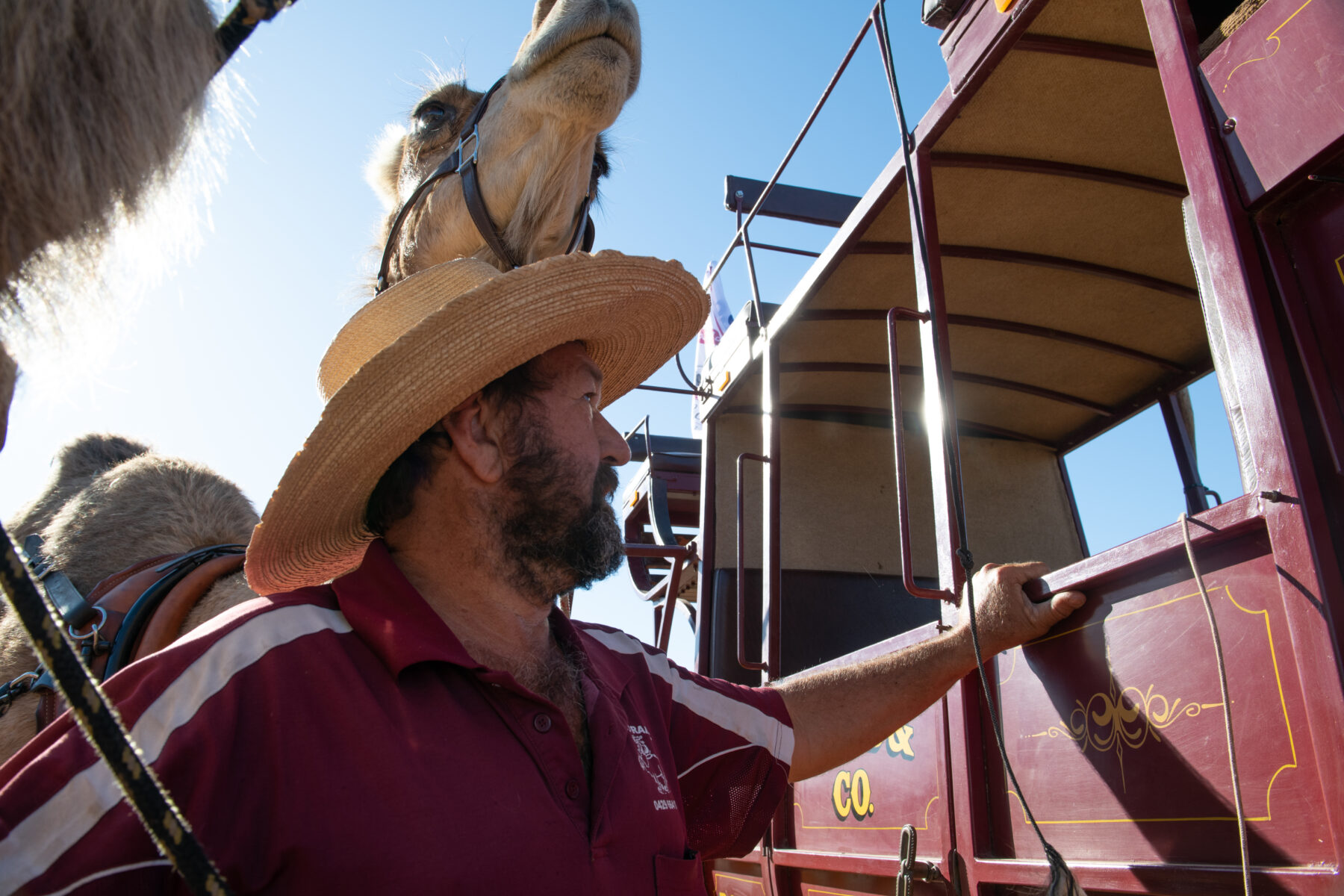
There are a few teary, nostalgic eyes watching the teamsters. “My grandfather worked as a bullocky; my dad rode in the Cobb & Co coaches,” someone says in the crowd.
Over at the Cobb & Co Store Museum, 2000 visitors have filed through the door in one day. They’ve come to see Kathy Ellem’s evocative teamster artworks and to listen to coach-builder Stephen Ralph. Jeannette Young, the Governor of Queensland, is among the throng.
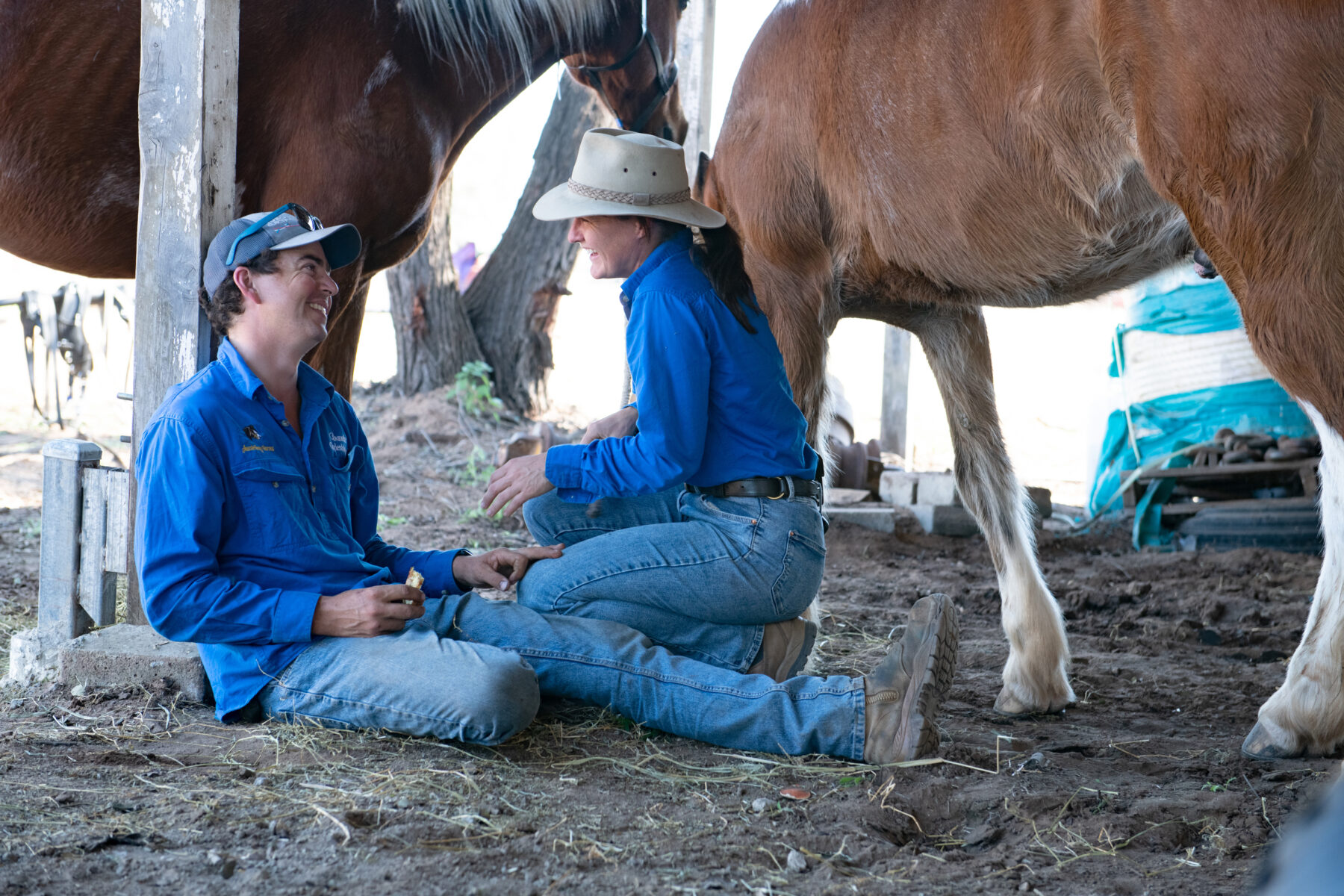
Overlooking the celebrations is a busy Joh Hancock, who owns the Surat Post Office. She’s also a Maranoa Shire councillor and an enthusiastic volunteer on the festival committee. “This festival is about celebrating our history, but it’s also important to put Surat and Yuleba on the map,” she says. “We’ve worked hard to make this a national event and that is validated by Australia Post and the Mint, which have released a commemorative stamp and coin. I look at Surat’s main street today and I see economic development, tourism and community coming together and I’m so proud of this small committee and their big hearts.”
Visitors are crammed inside the post office. The commemorative stamps are scored by postmarks, letters are deposited into a canvas sack and Surat postcards are doing a roaring trade. “I’ve never written on a postcard,” a teenage girl says, instantly ageing everyone else in line.
It’s gotta be love
It’s Saturday morning and a procession of riders and horse-drawn vehicles heads across the Balonne River to begin the two-day, 76km re-enactment of the last run to Yuleba. Behind them, the Cobb & Co coach once again stirs the air, horses prancing to a stop before the post office where Joh, in 1920s rural attire, hands over the precious mail bag. Then they’re off.
Nea MacCulloch is among 12 paying passengers rolling to the gait of the five coach horses. Stagecoach travel may be romantic, but it’s also noisy, dusty, bumpy and stuffy. On hot days, it would have been hell. On cold days, hell froze over. As Cobb & Co often carried shipments of gold, passengers would also nervously watch the passing scrub for bushrangers. Today, the bushrangers are from the Surat Pony Club and they are met with water-pistol fire.
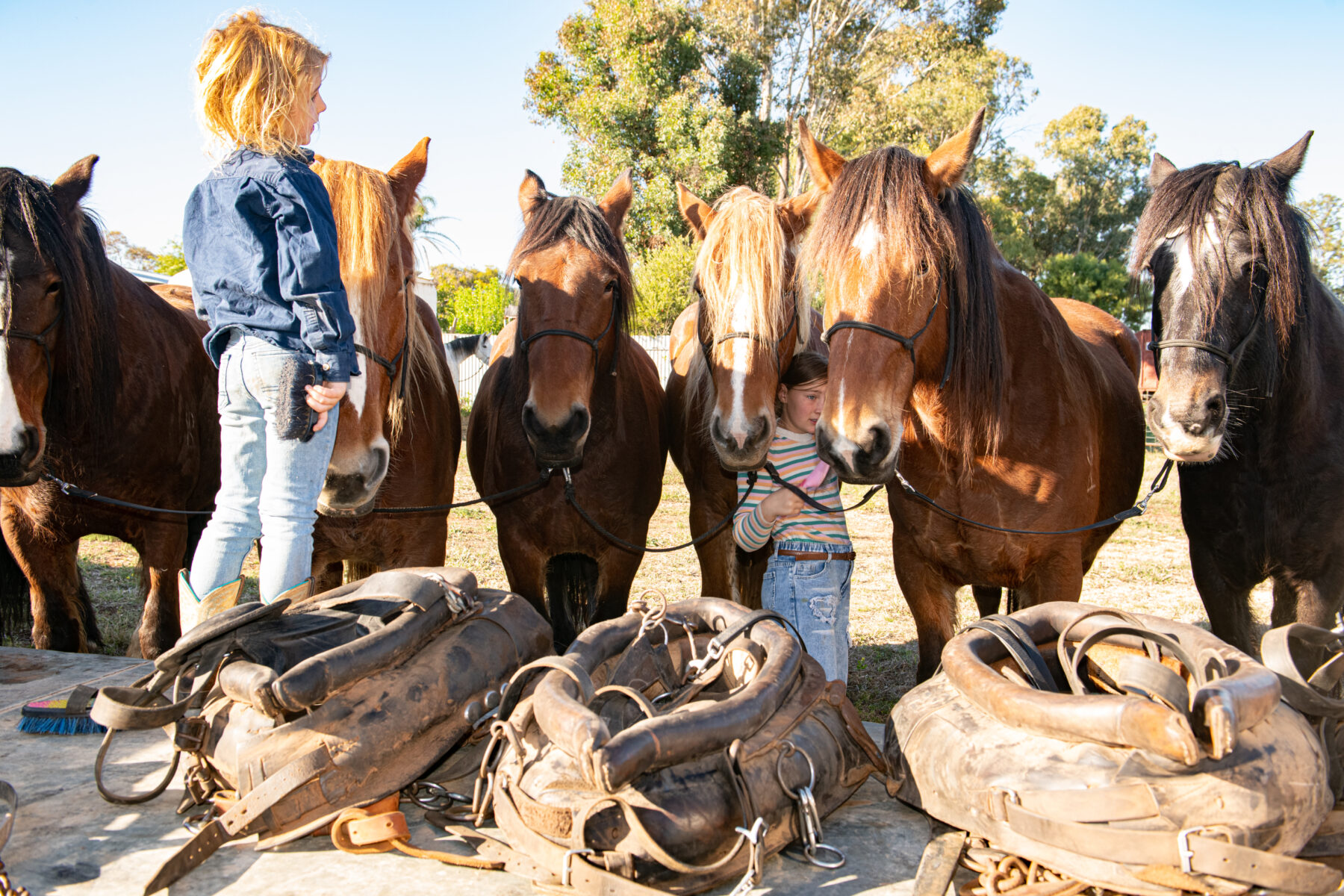
Hold-up averted, the horse-drawn vehicles and riders give way as the coach arrows through them, but they have their own stories and Cobb & Co affiliations.
“Lady Pearl, our waggonette, has the same leather thoroughbrace suspension as the Cobb & Co coaches,” Ian Stewart-Koster, of the Duneske Clydesdale Stud, says. “The quality of steel in the mid-1800s was variable and the roads and tracks coaches covered could be rough, so steel springs were susceptible to breaking. Leather thoroughbraces solved this problem. They are a collection of leather straps, mounted on the undercarriage, which support the body of the vehicle. This gives a forward and backward rocking motion, as well as a lifting effect if the coach should happen to bump into a log across the track.”
Joining Ian is his wife, Joan, Neil Hall and 14-year-old Bridgette Buckley, who’s learning the ropes and reins. Ian’s son Andy has other things on his mind. Andy and his girlfriend Lauren Booth have a more modern cart for two, adorned with the words: Cobb & Co Junk Mail – Daily Delivered with Style. It lends to their sense of humour, but this ride has special significance for them. “We met five years ago on this event,” Lauren says, “and we’ve parked the truck in the same spot for tonight. We’re going to celebrate.” This is somewhat of an understatement. Between the lunch and dinner camps, they secretly marry.

The emotional cavalcade stops every 10km or so, mirroring the Cobb & Co routes, where horses were swapped out at changing stations, allowing the coach to maintain speed and cover up to 80km a day. On this ride, passengers are also swapped. Bev Giveen, who sports a ruffled cap and eagerly awaits her turn, cannot wipe the smile from her face. She hails from Dee Why in Sydney, owns a half brumby, half quarterhorse and competes in barrel racing and flag events. Tonight, she will sleep in the front seat of her car. At 77, Bev could be the pin-up girl for this festival. “I’m horse and coach crazy,” she says.
The first day of the re-enactment ends on the Wallabella stock route, where newly installed troughs provide solace for thirsty animals and camp-oven meals fuel riders. Bridget Macintyre, from Kilkivan in Queensland, is an endurance rider. She asks the vet to check the heartbeat of her heritage stock horse, Rocky. Rocky is doing just fine.
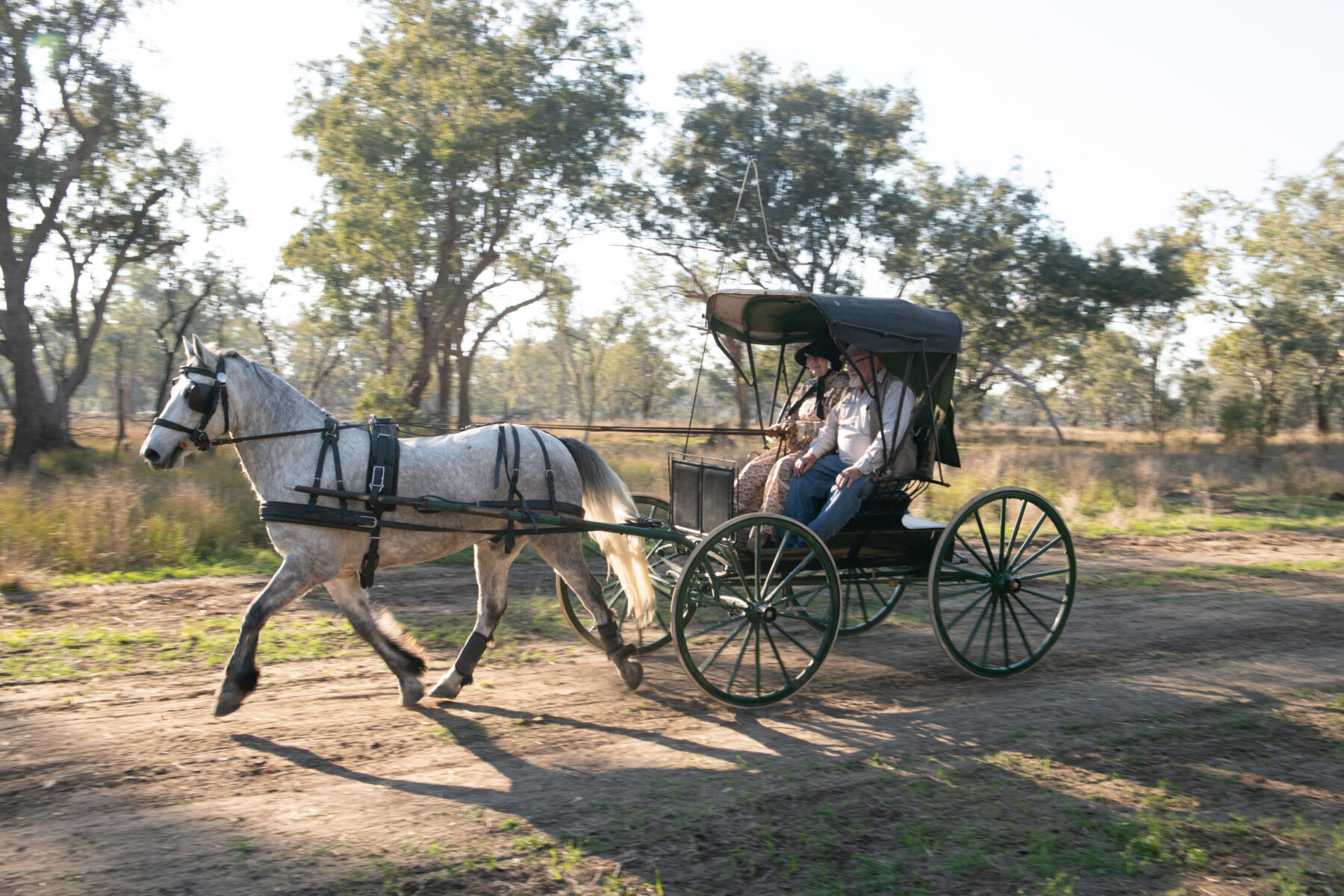
Also doing fine is Col Anderson, who’s driving her refurbished Jimboomba Royal Mail Waggonette. Not long ago she broke her leg while training for the ride and, with a plate and six screws inserted, is still moving slowly. “We’ve been working the horses specifically to get them fit for this event so I’m going the whole way and I’m loving every minute of it,” she says.
Dawn breaks on the final day of the 100-year re-enactment, and with it comes expectation. A steam train will meet the coach in Yuleba. The mail will continue its journey on conventional transport. Rod Sansom will be there with his camels, as will the bullocks and Australian Draughts. There will be singers and presentations and, appropriately, a display of vintage cars as it was motorised horsepower that eventually marked the end of Cobb & Co. Even Tommy Thompson, who drove the very last Cobb & Co coach, continued to deliver mail from a truck after 1924.
But in this moment, as the sun breaches the horizon and as horses are saddled or harnessed, the memory of Cobb & Co burns strong. Riders and horse-drawn vehicles leave early and once again, the coach is filled with passengers, the mail is secured under the box seat and the driver takes the reins. The coach departs, taking its energy with it and leaving those remaining with space to breathe and settle. History recedes. The coaching days are over.




